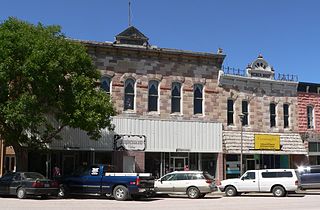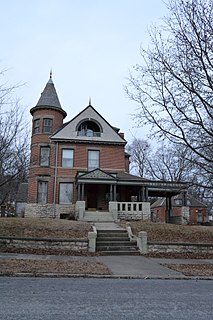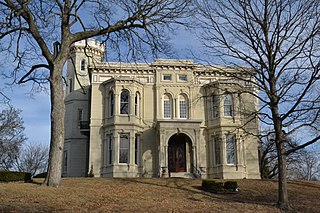
The Washington Avenue Historic District is located in Downtown West, St. Louis, Missouri along Washington Avenue, and bounded by Delmar Boulevard to the north, Locust Street to the south, 8th Street on the east, and 18th Street on the west. The buildings date from the late 19th century to the early 1920s and exhibit a variety of popular architectural styles of those eras. The majority of the district's buildings are revival styles or in the commercial style that would later come to be known as the Chicago School of architecture. Most buildings originally served as warehouses for the St. Louis garment district and are large multi-story buildings of brick and stone construction. Many have terra cotta accents on their facades. After World War II, the decline in domestic garment production and the preference for single-story industrial space led to many of the buildings being vacant or underused due to functional obsolescence.

Patee Town Historic District is a national historic district located at St. Joseph, Missouri. The district encompasses 71 contributing buildings and 1 contributing site in the Patee Town section of St. Joseph. It developed between about 1858 and 1939, and includes representative examples of Greek Revival and Italianate style architecture. Located in the district are the separately listed Patee House, a hotel that is a U.S. National Historic Landmark, and Jesse James House. Other notable buildings include the Morey Piro House (1910), Charles E. Herycele House (1903), R. L. McDonald Manufacturing Co. Warehouse (1899), Mrs. Pemetia Cornish Duplex, Fred Wenz Store Building (1903), Fire Station #5 (1939), German Salems Church, and Matthew Ziebold House (1895).

There are nine historic districts in Meridian, Mississippi. Each of these districts is listed on the National Register of Historic Places. One district, Meridian Downtown Historic District, is a combination of two older districts, Meridian Urban Center Historic District and Union Station Historic District. Many architectural styles are present in the districts, most from the late 19th century and early 20th century, including Queen Anne, Colonial Revival, Italianate, Art Deco, Late Victorian, and Bungalow.

The Chadron Commercial Historic District, located at Main St. & 2nd St. in Chadron, Nebraska, is a 12.9-acre (5.2 ha) historic district that was listed on the National Register of Historic Places in 2007. It includes buildings dating from 1888 and includes Romanesque Revival, Colonial Revival, and commercial vernacular architecture in some of its 41 contributing buildings and 20 non-contributing buildings.

South Michigan Street Historic District is a national historic district located at South Bend, St. Joseph County, Indiana. It encompasses nine contributing buildings on a commercial strip in South Bend. It developed between about 1911 and 1945, and includes notable examples of Classical Revival style architecture. The buildings are primarily two-story, brick commercial buildings, some with stone or terra cotta trim. They include the former Smith-Alsop Paint Store Building (1922), Myer-Seeberger Building (1916), Whitmer-McNeese Building (1928), and LaSalle Paper Company Building (1925).

Cathedral Hill Historic District is a national historic district located at St. Joseph, Missouri. The district encompasses 309 contributing buildings, 1 contributing site, and contributing structures in a predominantly residential section of St. Joseph. It developed between about 1860 and 1950, and includes representative examples of Greek Revival, Italianate, Queen Anne, Colonial Revival, and American Craftsman style architecture. Located in the district is the separately listed Virginia Flats. Other notable buildings include the Nisen Stone House, Thomas Culligan House, A. D. Hudnutt House (1909), St. Joseph Cathedral (1877), James Wall House, Taylor Apartments, E. F. Weitheimer House (1888), Sarah and Ann Walsh Apartment House (1915), Henry Owen Stable (1898), George T. Hoagland Speculative House (1901), and James Hull House (1887).

Dewey Avenue–West Rosine Historic District is a national historic district located at St. Joseph, Missouri. The district encompasses 37 contributing buildings and 1 contributing site in a predominantly residential section of St. Joseph. It developed between about 1880 and 1930, and includes representative examples of Italianate, Second Empire, Queen Anne, Colonial Revival, Tudor Revival, and American Craftsman style architecture. Notable buildings include the Marshall B. Stroud House (1890), John and Frank Whitman House (1890), Johanna Johnson House (1908), Frank Lacy House (1900), and a number of speculative houses built by Charles H. Nowland.

Harris Addition Historic District is a national historic district located at St. Joseph, Missouri. The district encompasses 288 contributing buildings and 1 contributing site in a predominantly residential section of St. Joseph. It developed between about 1866 and 1940, and includes representative examples of Colonial Revival, Tudor Revival, and American Craftsman style architecture. Notable buildings include the William Payne House (1889), W.C. Green Apartment Building, C.B. Powers House, the Parry-Notter House designed by architect Edmond Jacques Eckel (1845–1934), and a number of speculative houses built by George J. Englehart and W.H. Haynes.

Krug Park Place Historic District is a national historic district located at St. Joseph, Missouri. The district encompasses 28 contributing buildings and 1 contributing site in a predominantly residential section of St. Joseph. It developed between about 1888 and 1938, and includes representative examples of Italianate, Queen Anne, Colonial Revival, Tudor Revival, and American Craftsman style architecture. Notable buildings include the Henry Krug, Jr. House (1892) designed by architect Edmond Jacques Eckel (1845–1934),`A.V. Schaeffer House (1913), W.W. Van Sant House (1914), J.G. Schneider House (1899) by Eckel, Benton Quick House (1901), Mrs. W.B. Watkins House (1903), and George Ward House.

Kemper Addition Historic District is a national historic district located at St. Joseph, Missouri. The district encompasses 74 contributing buildings and 1 contributing site in a predominantly residential section of St. Joseph. It developed between about 1880 and 1950, and includes representative examples of Colonial Revival, Tudor Revival, and American Craftsman style architecture. Notable buildings include the Jacob Spencer House (1912), H. E. Hutchings House (1887), Fred Binz House, Thomas Moseley Duplex (1894), Plaza Apartments (1928-1929), Hickey-Fargrave House with alterations by architect Edmond Jacques Eckel (1845–1934),`C. E. Sprague House (1905) by Eckel, David Bartlett House (1900) by Eckel, and Samuel Nave House (1889).

St. Joseph's Commerce and Banking Historic District is a national historic district located at St. Joseph, Missouri. The district encompasses 39 contributing buildings in the central business district of St. Joseph. It developed between about 1859 and 1950, and includes representative examples of Italianate, Classical Revival, and Streamline Moderne style architecture. Located in the district are the separately listed German-American Bank Building, Corby-Forsee Building, Missouri Theater and Missouri Theater Building, and Missouri Valley Trust Company Historic District. Other notable buildings include the Ballinger Building (1889), Commerce Building, First National Bank of St. Joseph, Lehman's, Plymouth Building (1908), and the United Building (1917-1918) by the architecture firm of Eckel & Aldrich.

Missouri Valley Trust Company Historic District, formerly known as the Market Square Historic District, is a national historic district located at St. Joseph, Missouri. The district encompasses six contributing buildings in the central business district of St. Joseph. It developed between about 1859 and the 1860s, and includes representative examples of Renaissance Revival style architecture. The primary building is the Bank of the State of Missouri (1859).

Central-North Commercial Historic District is a national historic district located at St. Joseph, Missouri. The district encompasses 18 contributing buildings in an industrial / commercial section of St. Joseph west of the central business district. It developed between about 1885 and 1929, and includes representative examples of Italianate and Classical Revival style architecture. Located in the district is the separately listed John D. Richardson Dry Goods Company. Other notable buildings include a number of warehouse / light manufacturing facilities some of which were designed by the architectural firm of Eckel & Aldrich.

Museum Hill Historic District is a national historic district located at St. Joseph, Missouri. The district encompasses 248 contributing buildings in a predominantly residential section of St. Joseph. It developed between about 1860 and 1942, and includes representative examples of Italianate, Second Empire, Queen Anne, Tudor Revival, American Foursquare, and Bungalow / American Craftsman style architecture. Located in the district is the separately listed Robidoux School. Other notable buildings include the First Congregational Church (1890), Francis Street Methodist Church (1905), First Baptist Church (1896) designed by architect Edmond Jacques Eckel (1845–1934), United Presbyterian Church (1901), First Church of Christ Scientist (1905), First English Evangelical Lutheran Church (1913), and Queen of the Apostles Roman Catholic Church (1908) designed by Eckel.

Wholesale Row, also known as the Wholesale Row Historic District, is a national historic district located at St. Joseph, Missouri. The district originally encompassed five contributing buildings in an industrial / commercial section of St. Joseph on the western edge of the central business district. The Noyes-Norman Building (1872) on 3rd Street has been demolished. It developed between about 1872 and 1884, and includes representative examples of Italianate style architecture. The remaining buildings are the R.L. McDonald and Co. Building (1880), Englehart-Winning Co. North Building (1884), Englehart-Winning Co. South Building (1880), and Brittain-Richardson and Co. Building (1882). The remaining buildings were all designed by the architect Edmond Jacques Eckel (1845–1934).

Walnut Street Commercial Historic District is a national historic district located at Springfield, Greene County, Missouri. The district encompasses seven contributing buildings in a commercial section of Springfield. The district developed between about 1895 and 1949, and includes representative examples of Italianate and Colonial Revival style architecture. Located in the district is the separately listed Landers Theater. Other notable buildings include the Masonic Temple (1906).

South Avenue Commercial Historic District is a national historic district located in Springfield, Missouri, United States. The district encompasses 10 contributing buildings in a commercial section of Springfield. The district developed between about 1895 and 1949, and it includes representative examples of Italianate and Colonial Revival style architecture. Notable buildings include the Medical Arts Building (1929) and Springfield Life Building/Savoy Hotel/Hotel Seville.

The Sedalia Commercial Historic District is a national historic district located at Sedalia, Pettis County, Missouri. It encompasses 102 contributing buildings in the central business district of Sedalia. The district developed between about 1870 and 1959, and includes representative examples of Italianate, Romanesque Revival, and Art Deco architecture. Located in the district are the separately listed Hotel Bothwell, Building at 217 West Main Street, and Missouri/Sedalia Trust Company. Other notable buildings include the First United Methodist Church (1888-1891), Pettis County Courthouse (1924), Anheuser Busch Bottling Works, the New Lona Theater (1920), Citizens National Bank Building, Third National Bank (1929), Federal Building (1930), Montgomery Ward Building (1936), the Uptown Theatre (1936), Missouri Pacific Depot, and Central Presbyterian Church.

North Third Street Historic District is a national historic district located at Louisiana, Pike County, Missouri. The district encompasses 61 contributing buildings, 1 contributing site, and contributing structure in a predominantly residential section of Louisiana. It developed between about 1843 and 1935, and includes representative examples of Greek Revival, Gothic Revival, Italianate, Queen Anne, Colonial Revival, and Bungalow / American Craftsman style architecture. Located in the district are the separately listed Louisiana Public Library and Luce-Dyer House. Other notable buildings include the William C. Hardin House, James H. Johnson House, Edward G. McQuie House, St. Joseph's Catholic Church (1874), and Frank Boehm, Jr. House.

Moberly Commercial Historic District is a national historic district located at Moberly, Randolph County, Missouri. The district encompasses 89 contributing buildings in the central business district of Moberly. It developed between about 1880 and 1963, and includes representative examples of Classical Revival, Colonial Revival, and Italianate style architecture. Notable buildings include the former Moberly Post Office (1915), Moberly Masonic Lodge, No. 344/Israel Shrine #13 (1929), Fourth Street Theatre (1913), and Carnegie Library (1903).


























